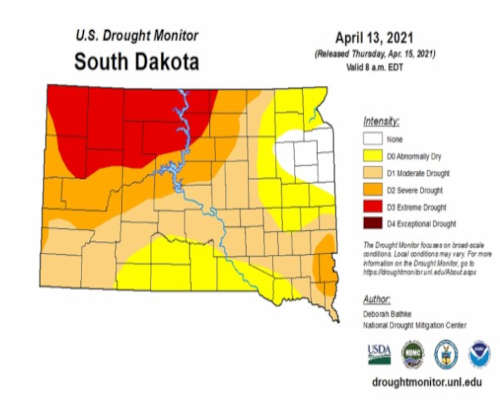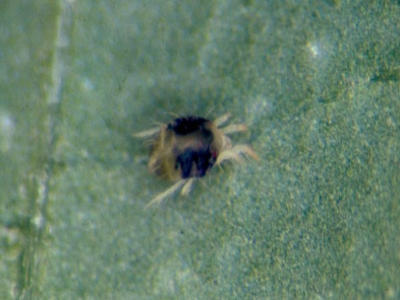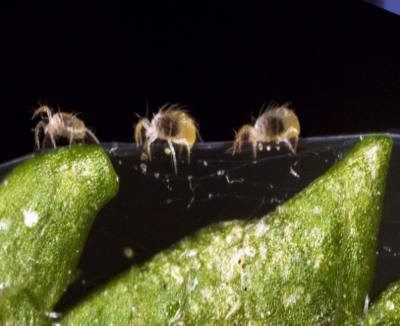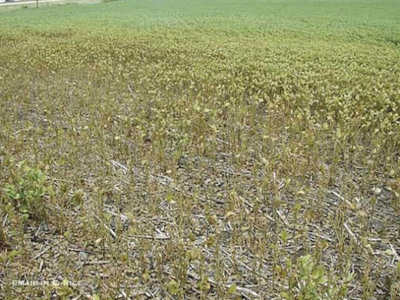By Adam Varenhorst
With the 2021 growing season underway, drought conditions vary in South Dakota with most areas being between abnormally dry (D0) and extreme drought (D3) (Figure 1). Although many of the crops are just emerging or are yet to be planted, it is important to consider the implications that the drought conditions may have on pest populations. Although it isn’t an insect, the twospotted spider mite (Tetranychus urticae) is an occasional pest of crops in South Dakota, and its populations can rapidly increase during dry conditions.

Figure 1. U.S. Drought Monitor for South Dakota as of April 13, 2021.
During most seasons, twospotted spider mites generally reach their highest population levels in late July or early August when dry and hot weather conditions are favorable for their growth. However, twospotted spider mites can start building populations in June during dry years that have early-season temperatures that exceed 85°F with a relative humidity that is less than 90 percent. Although we experienced one warm week in April so far, the cooler temperatures that we are currently experiencing are obviously not favorable for the twospotted spider mites. Conditions could potentially become favorable in late April or May, so we need to stay vigilant. Twospotted spider mite populations are capable of increasing very rapidly and will increase yield loss for already drought-stressed crops. When left unmanaged, twospotted spider mites are capable of reducing soybean yields by 40-60%.
Scouting and Identification

Figure 2. Twospotted spider mite adult. Courtesy: Frank Peairs, Colorado State University, Bugwood.org
A hand magnifying lens is recommended to scout for twospotted spider mites as they are very small (< 1/60 inches long) and may be confused for specks of dirt (Figure 2).
Young twospotted spider mite nymphs have 6 legs while later instar nymphs and adults have 8 legs.
Another method for determining the presence of twospotted spider mites is to collect leaves, shake them onto a white piece of paper, and then examine the paper for specks that are moving.
Twospotted spider mites are typically a cream or green color when feeding on corn or soybean. They can also be an orange to red color when conditions are unfavorable for their growth.

Figure 3. Twospotted spider mites traveling on webbing that is present on a leaf.
Scouting should also be focused on healthy areas of the field that are downwind from heavily infested areas. Although twospotted spider mites don’t have wings, they can disperse on the wind to move throughout a field. Twospotted spider mites reside on the underside of leaves and will create a thin webbing on the leaves that they form colonies on (Figure 3). Early signs of a twospotted spider mite infestation are small yellow or white spots (stipples) on the lower leaves of the plants. Prolonged feeding will cause the infested leaves to turn completely yellow, then brown, and eventually they will die and fall from the plant. The webbing is visible on the edges and underside of leaves and is an indication of prolonged colony feeding. Infested areas within a field will often appear as yellow circular areas that expand outward (Figure 4).
Management

Figure 4. An area within a soybean field that was heavily infested by twospotted spider mites.
There are no established economic thresholds for twospotted spider mites. However, scouting for initial infestations is very important to avoid yield loss. Organophosphates are the recommended insecticidal chemistry for twospotted spider mite management. Products containing the active ingredients dimethoate or chlorpyrifos are typically effective at reducing twospotted spider mite populations. These products target the nymphs and adults, but egg survival is likely so treated fields should be scouted again 7-10 days after application. The use of pyrethroid and neonicotinoid insecticides can actually result in an increase of twospotted spider mites as many of the active ingredients remove mite predators. One pyrethroid active ingredient that can be used is bifenthrin.
During dry conditions, management should occur when plants have substantial stippling or leaf-yellowing and the twospotted spider mites are observed on the plants. When temperatures drop below 85°F and humidity levels are greater than 90 percent for an extended period of time, twospotted spider mite populations will not increase as quickly and may be managed by a naturally occurring fungal pathogen.
Source : sdstate.edu